11.16.15Guest Post: KIPP Infinity’s Jeff Li on How Peer Tutoring Can Transform Math, Part 1
Jeff Li is an 8th grade math teacher at KIPP Infinity in Harlem. Over the summer I started to hear soundings about his work with peer tutoring from various people I know in the city, and I reached out to Jeff to find out more. What he shared was pretty amazing, and after some prompting in which he noted that he didn’t think he had it all figured out yet, was still learning, and wanted to make sure all the people involved got credit, he agreed to write up some notes. What he shared, part one of which appears below, is pretty amazing.
PEER TUTORING ON STEROIDS
The math department at KIPP Infinity is fired up. Part of our fire is due to the fact that we have a long way to go before we are certain we are providing the same level of education to our students that kids in affluent communities are getting, and ultimately to ensure that we have true educational equity in our country. In other words, we are fired up to try to get better.
At the same time, we are fired up because we have reason for a great sense of optimism. Our 8th grade cohort – a representation of our cumulative effort over four years of middle school – had the strongest year of any of our cohorts yet. Our students performed as well or better than the vast majority of schools in New York state on the New York State exam, including in affluent districts like Scarsdale. We accomplished this with high levels of students with IEPs (29%, compared to 19% average in NYC public schools) and a significant number eligible for free or reduced price lunch (over 90%).
There are many factors that led to these results – not least of which is our dedicated team at KIPP Infinity and a school culture that values teaching, learning, and character development , but I wanted to write about one aspect that has proved particularly powerful: Peer tutoring.
This is by no means a new or unique idea – peer tutoring is a part of many educators’ work. I think what might be additive here is the extent to which peer tutoring has become a fabric of the classroom culture and a key driver of results, both in academics and in the character of the students. In other words, peer tutoring on steroids.
WHY I THINK PEER TUTORING WORKED
Here are some hypotheses about why peer tutoring might have been effective.
1. Provides one-to-one feedback. Peer tutoring increases the level of one-to-one academic feedback for students.
Early in my teaching career, I worked with a lot of small groups. During class, at lunch, after school – I would tutor groups of 6-10 kids. And it kind of worked. But even small group interventions weren’t as powerful as I hoped they’d be. Stronger kids in the groups would drive the learning forward, but the most struggling kids could still hide or not get their needs met. Peer tutoring brings the ratio of students to tutors to its ideal: 1:1. If there are 10 students that need tutoring, you invite 10 tutors also. This supercharges small group interventions and students benefit from individualized feedback and accountability. 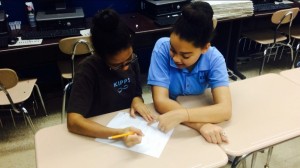
2. Lowers math anxiety.
A recent study at Stanford showed that one-on-one tutoring over a sustained period led to a significant decrease in math anxiety. My own anecdotal experience is consistent with this finding – students who would otherwise be afraid to ask questions or attempt problems are much more comfortable doing so in a one-to-one tutoring environment.
3. Deepens understanding through teaching. Peer tutors themselves internalize the concepts much more deeply when they are tasked with helping others understand.
After a year, I was stunned by the growth that I saw in the tutors themselves. I had wholly underestimated this part. By pushing them to uncover other students’ misconceptions, by exposing them to different students’ reactions to the same math problem repeatedly, they became much stronger mathematical thinkers themselves. We saw tremendous growth in our strongest students (over 40% of our students performed above the 90th percentile on the nationally-normed NWEA MAP exam). In fact, when I was announcing our results to some kids, without prompting, one of the kids blurted out, “We did that through peer tutoring!” They seemed to know how powerful it was themselves.
4. Reframes self-concept. Peer tutoring helps re-frame students’ perceptions about their role and purpose in math class.
I was also surprised at how peer tutoring served to re-frame students’ concept of self. No longer were they only in math class to serve only their own learning – they were there to help others. This changed the way they viewed themselves and their role. One student who was often absent and had struggled to engage in school asked me quietly early in the year if he could be a peer tutor. He had strong math skills, so we took a chance with him. By making him responsible for others, we stumbled into a strategy to improve his own attendance and engagement greatly. No longer did he amble slowly into class. He walked into math class with a purpose. Even when he imploded in an earlier class or situation, he would often gamely show up to math class, losing himself in helping others.
Here are his own words:
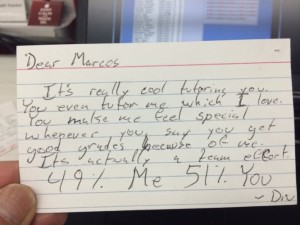
5. Increases ownership. Peer tutoring empowers students to take ownership over the collective learning in the classroom.
One of my colleagues, Lelac Almagor, once wrote a paragraph about adolescents that I’ll try to paraphrase: “They are, in many ways, trying to gain a measure of power over their own lives. If they sense that you are fighting them for that power, they will fight you to the death for this. But if they sense that you are empowering them, there is no limit to how far they will go.” I experienced this with peer tutoring. The kids felt an ownership over their learning, and took over the whole thing. They would tutor each other on the weekends without consulting me – how dare they? J – and when some of them would miss class, other students would often ask me if they could stay during lunch to help a teammate. It became part of the fabric of the classroom, and absolutely increased the level of investment and ownership the kids felt.
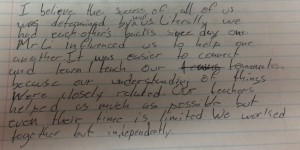
Part 2: STRUCTURE Ordinarily you might think of Peer Tutoring as something that happens only at a specific time of day—after school for 45 minutes, say, but peer tutoring for us became a part of the entire school day.
1. During class. During class, each student was seated next to a student who could be a peer tutor. At any time, a student could ask for help – during the warm-up, during independent practice, etc. There were small pockets of time that I “outlawed” peer tutoring – for example, for the first 3 minutes of independent practice, to ensure that tutees actually tried it on their own for a while – but it was allowed nearly all of the time on non-test days.
2. Lunch and after school. For all of my small group intervention, it was peer tutoring all of the time. I would spread students around the classroom in pairs (never trios) and they would focus on completing the day’s HW with quality and understanding.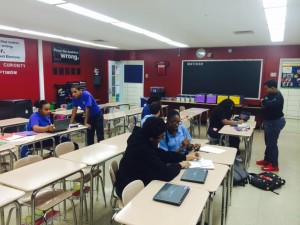
3. Any intersection of the day. If we had any unstructured time during the day – for example, while regular-time students were in an activity while waiting for the extended-time students to finish an assessment – I would pull kids to tutor each other.
Anyone could be a tutor at any time. Because peer tutoring became such a big part of the culture, I trusted everyone to tutor others when it was the case that they had skills that others did not. By giving that power to the students right away – rather than some big “earning” process – I felt it made the tutors really step up to the plate and be their best selves. For example, this was particularly effective when a student who might struggle tutored a stronger student who had missed class the previous day. The struggling student was forced to play the role of teacher, and thus internalize the concepts and explain; the stronger student had to try to figure out the lesson with only minimal scaffolding from a student who had less strong math skills.
My job became the monitoring of the quality of tutoring, rather than on math intervention. I started doing much less math intervention, and spent more of my time monitoring the environment. This spread the responsibility for learning among so many, and helped me enormously, given my energy level. It can sometimes be exhausting to teach the same concept three times in a day, much less tutor even 3 or 4 kids again on the same concept – you can sometimes get stale. And so I focused on doing it well three times, during the regular class, and then let our “second shift” of tutors take over after school and during intervention blocks. Not only did this help me sustain my energy level, it was powerful for the kids as well, as they often thought their fellow students were better teachers than the adults (they try to be nice below, but that’s what they are basically saying 🙂 :
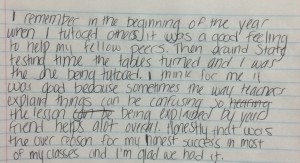
Look for Part 2 of Jeff’s post soon!

I’m inspired by your discussion about peer tutoring. Thank you! I am a curriculum writer for Eureka Math, which has been adopted by a number of KIPP schools across the country. Are you using our math curriculum in Harlem?
Jeff will have to reply to that one. But I’m glad the post was useful, MaryJo!
Love it! Great stuff — hungry for more on this, Jeff — looking forward to part 2 and more tactical suggestions if possible. Putting this into action in Kenya / South Africa starting in January
So happy to know it. Thanks, Dai.
That makes me so happy to read. Thanks for everything you do on behalf of kids!